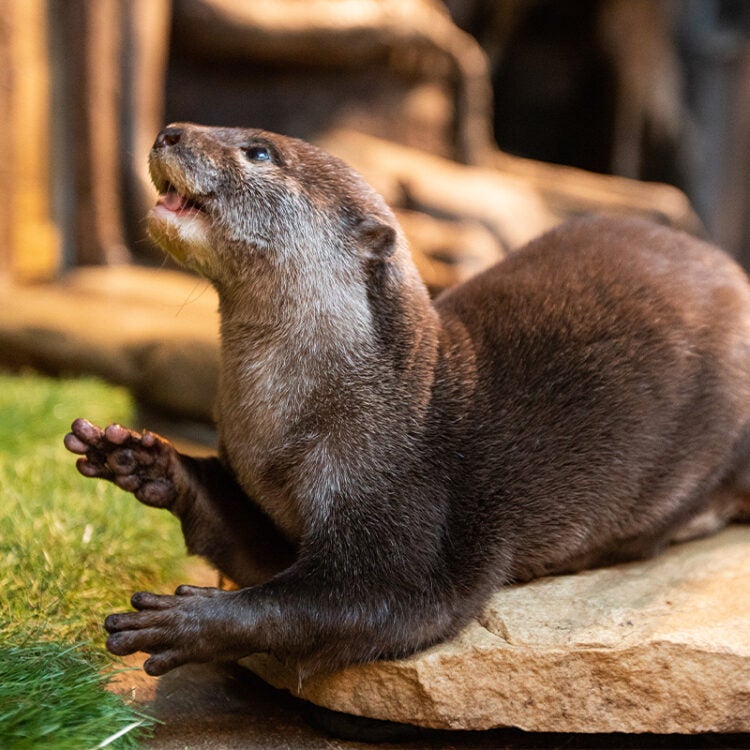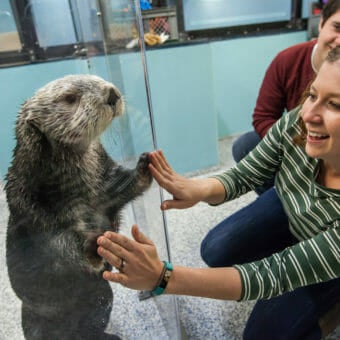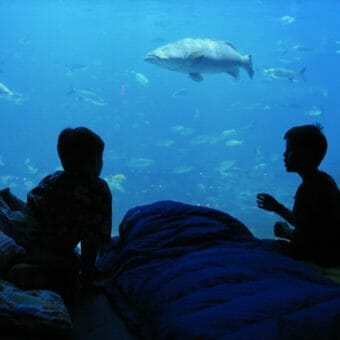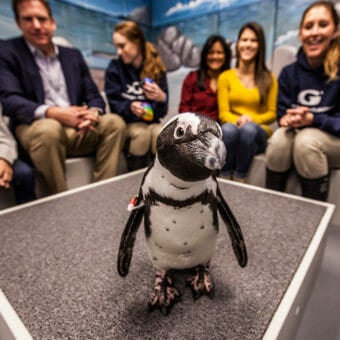-
Size
4 to 11 lbs (2-5 kg) -
Diet
Mollusks, fish, frogs, and crustaceans -
Range
Southeast Asia and southern India -
Habitat
Freshwater wetlands and mangrove swamps
Physical Characteristics
Size
- The world’s smallest otter. It ranges in size from 4 to 11 lbs (2 – 5 kg), with a head and body length of 16 to 24 inches (41 – 61 cm) and a tail length of 10 to 12 inches (25 – 30 cm).
Fur/Whiskers
- Predominantly dark brown in color with a lighter patch on its throat. Fur is relatively short.
- Whiskers help it to detect changes in water current and pressure.
Swimming/Diving
- The body is also adapted for diving, in that its heart rate and oxygen consumption are reduced while submerged. The otter can also seal its nose and ear canals while underwater.
- The body of the small-clawed otter is elongated so that it can easily move through the water.
- Feet are only webbed to the last joint and are tipped with short, blunt claws. This structure aids in swimming, and still allows considerable dexterity.
- The tail is very thick and muscular at the base and is gradually tapered to a thin tip. Lateral motions of the tail help to propel the otter while diving.
Vision
- The eyes adjust easily as the otter goes from land to water. In bright light, vision was found to be equal in air and water.
Animal Fact
The Asian small-clawed otter can adapt and change its heart rate for diving.
Diet / Feeding
- The Asian small-clawed otter is a carnivore feeding on mollusks, fish, frogs, crabs and other crustaceans.
- Foraging is done mainly at the shoreline or in shallow water and is done almost entirely with the front paws.
- Teeth are well-suited for a varied diet that includes shellfish. Canines are sharp and pointed, and molars are broad and strong.
Range / Habitat
Range
- Occurs in southern India, southern China, and parts of Southeast Asia.
Habitat
- Asian small-clawed otter is found in freshwater wetlands and mangrove swamps, and at higher elevations, it is associated with fast-flowing, rocky streams.
- This shallow-water otter is mainly diurnal, commonly observed sliding on mud banks, foraging in the shallows, and chasing others through the water.
Reproduction & Growth
- The female gives birth to one to six pups per litter. Pups are born small and do not open their eyes until they are about 40 days old. They start to swim at about 60 days old and eat solid food at around 80 days.
- Both males and females provide care for their young.
- Sometimes the young will stay with their parents into adulthood and form a small social group of up to 12 individuals.
Conservation Status
- “Vulnerable” on the IUCN Red List.
- Appendix II of CITES
- Wetlands, where it resides, are being destroyed due to changing land uses and development.
- In addition, environmental pollution threatens these otters and drastically reduces their food sources.
Additional Information
- This species is the least aquatic of the 13 species of otters all within the subfamily Lutrinae.
- Compared to other otter species, the Asian small-clawed otter spends more time on land than in the water even though they typically are in the water more than half of the day. Whether in or out of the water, these otters spend their day hunting, at “play,” or resting in reed nests, rock caves or burrows.
- Otters are members of the mustelid family, related to badgers, minks and weasels.
- Asian small-clawed otters are a social species, usually living in extended family groups numbering around a dozen individuals.
- Can communicate by using up to 12 different calls.
- Social grooming is often observed.
- This species leaves small feces or urine deposits to communicate, but will also use a communal latrine, where it will stomp hind paws on the waste in order to grind it into the substrate.





